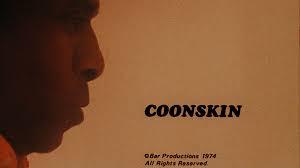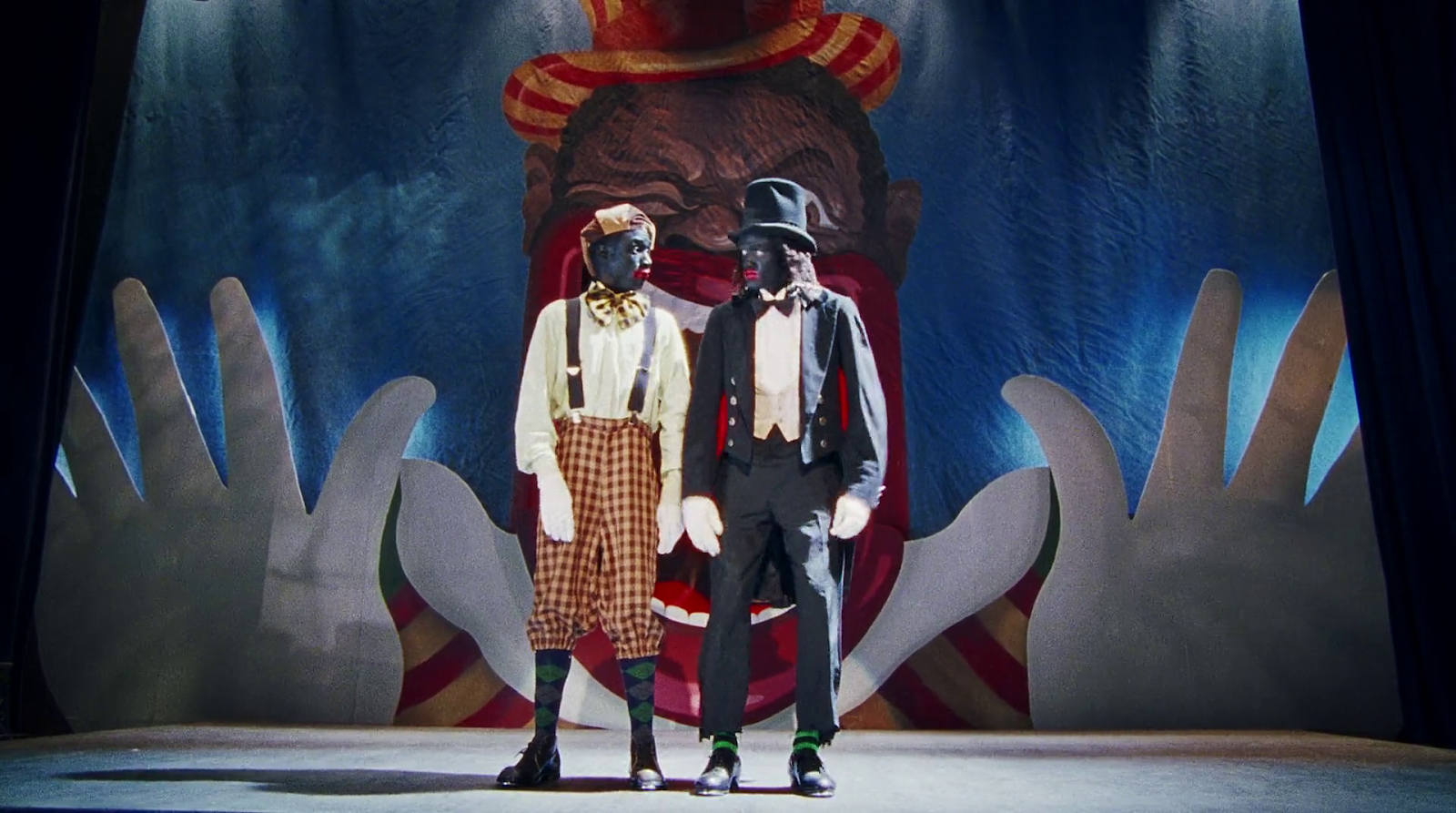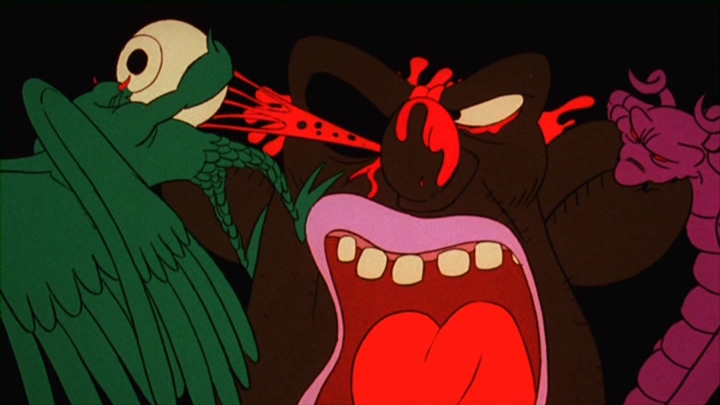Ralph Bakshi's Coonskin and Spike Lee's Bamboozled were heavy-hitting satirical films about racism that received mixed reactions among audiences and critics when they came out. Over time both films have gained a cult following for their political relevance presented through their themes and off-the walls violent, and offensive racist imagery. However, while many articles, video essays, and books highlight films making a statement about racism through comedy, whether it is a parody like Blazing Saddles or a drama with dark humor like Do the Right Thing, Coonskin and Bamboozled do not receive the same attention. Why should they deserve more attention, and what do they share outside of their divided reception?
By looking at the promotional material before seeing the films, Bakshi and Lee make it clear they are not wearing any kid gloves when satirizing racist material. Whether it is the image of a cartoon bunny in Blackface pointing a gun, or people in Blackface, there is no doubt that the material in either film will be hard to watch. A big part of what both films satirize is the racial stereotypes carried through the film and television media. However, each film criticizes Black racial stereotypes through different genres of entertainment.
Spike Lee does address the racist depictions of Black people in cartoons at the end of Bamboozled and with some bits of computer-generated imagery throughout the movie, but his film focuses on the people physically performing in front of the camera as racial stereotypes of Black folk. The apparent target getting satirized is the concept of Blackface, and while the film would have white people in Blackface, the primary entertainers in Blackface for most of the film are not white. The actors in Blackface are African Americans, which to modern white audiences may sound odd. However, the reality is that some Black actors during old Hollywood, and minstrel shows (most notably Bert Williams) were required to darken up their skin for not appearing dark enough. Lee's primary goal of using Blackface is to comment on the demeaning roles Black entertainers would play throughout history to make white audiences laugh, in Blackface or not, and its relevance in modern media.
The opening prologue to Coonskin functions similarly to Spike Lee's overall themes of racial satire in his film. With little word of warning or build-up, the first image has two Black caricatures hanging on the street, making jokes and one moving as exaggerated as actors would on minstrel shows. Just as Spike Lee achieves satire in his themes of media's racial stereotyping through African America actors, Coonskin uses Black actors to voice the animated minstrel like-characters. The designs for these two black men are tasteless, but the dialogue and performances are not played out for white audiences to laugh at them. Both characters directly curse at the viewer and joke about the statistics (at the time) of white people committing suicide at the Golden Gate bridge and how only two were Black, and "one of them was pushed." The scene is concise, but it makes itself clear that the film is not designed to comfort any audience watching it. The opening credits sequence follows with live-action footage of Scatman Crothers passionately singing and scatting a song that sounds as upbeat as Zip-a-Dee-Doo-Dah but lyrically is not cheerful. Crothers sings about the racial slurs Black people have been called, how they have been oppressed, and their stereotypical roles in American white society as servers or entertainers.
The lyric "Watch me dance," is Crothers' response when labeled under the infamous N-word, foreshadowing the actions the tap dancer Manray would have with audiences referring to him through the racial slur in Bamboozled. Unlike how Coonskin immediately gets to its repulsive imagery, Bamboozled builds to it slowly. Before getting a job working in a modern minstrel show, Manray and his manager Womack were homeless. Their only way to receive cash to eat was by dancing on the street through their tips. The opportunity to make plenty of money by performing for wider audiences seemed like a dream come true. It is not until Manray and Womack realize that their fame would come with a high price after discovering the minstrel concept of the show they are signing up for. The two would not just wear Blackface to appear darker but play dimwitted lazy slaves working on a watermelon patch under the names of Mantan and Sleep n' Eat (named after black entertainers Mantan Moreland and Willie Best). Both characters' situation reflects how many other Black actors were suffering in showbiz. With the entertainment industry primarily run by bigoted white men, Black people did not receive as many opportunities. They were typically only allowed to play buffoons, savages, or servants. If a Black entertainer did not want to play any of those roles, they would have little to no work; it was either get paid to play into the black stereotypes or go broke and hungry. Hence why stars like Bert Willaims, Mantan Moreland, Willie Best, and notably Hattie MacDaniel had to play the roles, they were given.
Coonskin's way of telling a story is more out of the ordinary. At first, the film takes a familiar approach by having the movie start in live action after the prologue to launching into animation when the prisoner Randy hears a tale from his cellmate Pappy as they wait to make their escape. The transitions from live action to animation mirror the narrative structure from Song of the South, with Pappy serving as the foul-mouthed Uncle Remus, except most of the film is in animation. In contrast, the Disney film is presented in live action with four animated segments. The animated story in Coonskin has a clear beginning, middle, and end. However, it takes plenty of detours in the plot by creating a series of vignettes showing Black people living in America. Some of the vignettes in the film would focus on the poverty of Black people living in the slums or digging through trash cans.
Most of the shorts that take a break from the plot feature a character called Miss America, a tall, beautiful white prostitute dressed in red, white, and blue. Miss America's character represents the long and continuing history of oppression of the abuse African Americans have suffered in the U.S.A., as most of the shorts have her seduce Black men and abuse them. One short involves a Black man in rags singing and dancing to her as she sits down holding a guitar. To get rid of the man for good, Miss America casually calls for help claiming she is being raped, causing a noose to materialize and hang him despite committing no crime. While he hangs, Miss America sits down, playing guitar as gracefully as a hippie folk singer acting as if nothing happened. The only time Miss America ever shows support for African Americans is for selfish gain, which occurs whenever she meets the film's main characters. When Brother Bear becomes a champion boxer, she congratulates him for practically making a career out of beating up Black people to entertain typically white people.The idea of having a film depicting racism in an urban setting using scenes that can stand on their own is a method of storytelling Spike Lee would use for Do the Right Thing and even Bamboozled. During the show's televised premiere, the film's plot breaks for a few commercial parodies. One of the commercials satirizes the Tommy Hilfiger clothes brand. The last name Hilfiger now has the use of the N-word attached to Hil, as the white CEO himself, Timmi, surrounded by gangsta rappers and dancing Black women, promotes hood clothing to "keep it real." Timmi shows no restraint in using the N-word when promoting his clothing for his claims of coming from the hood. Timmi is not subtle about addressing poor people to buy his clothes to add his "multibillion-dollar corporation" for making it sound hip "to be broke" and "stay in the ghetto." The concept of the satire speaks for itself of how white-owned clothing brands tend to manipulate young African Americans to spend money on clothing that they claim to represent their culture.
The commercial sequence is just as on the nose as the film's closing montage of clips showing how African Americans have been depicted throughout the media in various horrific ways. What makes it shockingly effective is the juxtaposition of calm music playing as the sequence shows one offensive image after another, reminding the viewer how this imagery was (and still is) seen by white audiences as inoffensive entertainment. The scene challenges the white viewer after the film's events to see if this imagery is still harmless to them. Even without seeing the film, the montage works just as effectively on its own by testing the viewer without them acknowledging it.
Most of the film's vignettes are the minstrel show scenes. Outside of the scenes with the actors performing in Blackface, the film is shot on a mini digital camera giving the picture a low-quality look, as if the audience is watching a fly-on-the-wall documentary. The documentary-like look serves as a way for Lee to say these characters may not be real, but what is happening behind the scenes in the entertainment industry towards Black actors is not as far-fetched as you think. Some scenes are deliberately intended to appear in inferior quality, like the commercials. But the scenes with Manray and Womack performing in Blackface in front of a television audience are in high-depth cinematic quality. The difference in quality is to make it feel like the audience is watching an episode from the show, as each scene would have the characters tell jokes, sing, dance, and occasionally go on misadventures. Spike Lee makes it clear throughout the film how distasteful Blackface is through the characters' conversations and reactions to the imagery yet allows these scenes to drag. There are a few reasons why these scenes go on longer than they should. The clearest one is watching the two performers suffer as they smile on the outside yet are tortured inside for selling any dignity they had for money and fame. Another reason is to allow the film to present racial stereotypes to a modern generation to show how shocking and offensive they can be years later yet still be widely accepted by white audiences. The third and most intriguing reason is to study how minstrel shows have lasted so long. Dehumanizing African Americans was the essential draw for white audiences to confirm that what they see is how Black people are, but they were not viewed as cheap gimmicky entertainment. Actual talent was involved when creating and performing the minstrel shows. These were not just actors in Blackface that just stood there and told jokes; these were people that moved like cartoon characters (before the medium was invented) and could actually sing and dance, which Spike Lee captures. At one point, Lee briefly shows the demanding work that goes into the choreography in one scene. The downside is that all that effort is towards an art form at the expense of demeaning an entire race.
The vignettes in Coonskin are short compared to Bamboozled. The scenes that Ralph Bakshi usually drags out are the death scenes. The antagonistic Black characters die quickly on-screen, whereas the white people running Harlem who oppress the community suffer greatly. One of them is the corrupt, crooked police officer Managan, who not only heavily despises African Americans but is a homophobe as well. A character who extorts money from criminals rather than arresting them, waves his gun around to scare away the Black residents of Harlem and violently abuses anyone Black or gay for the slightest thing they do. Rather than Brother Rabbit just drugging him and killing him while intoxicated, a stereotypical gay man takes advantage of him. Then Brother Rabbit has Managan painted in Blackface, throws him in a dress, and tossed outside the back of the club, where the police violently shoot him down. What is an extreme and abnormal way for a character to go is still an appropriate fitting demise in the film's animated realm. He dies resembling the people he hates in their unflattering depiction in entertainment and suffers the cruelest form of police brutality as countless loads of ammunition are unloaded on him, even after his dead body collapses.
Police authority towards African Americans is criticized a few times in Bamboozled, at the very beginning when evicting homeless Black people staying in an abandoned apartment for the sake of it or arresting the only non-Black member after killing a gang of violent underground rappers called the Mau Mau's. However, the antagonistic authority figure is not a police officer but one of the heads of the TV studio, Thomas Dunwitty. Though Dunwitty is not as subtle as one of Spike Lee's famous antagonists, Sal from Do the Right Thing, his character is just as fascinating. Like the Tommy Hilfiger commercial satire, because Dunwitty grew up with African Americans and married a Black woman, he arrogantly thinks he is allowed to judge what is qualified as good entertainment representing people of color. Despite hiring a Black man, Pierre Delacroix, who understands what Black audiences want, Dunwitty rejects his show pitches that give a dignified portrayal of African Americans, believing he is only white-washing Black culture. But when Dunwitty is offered to produce a minstrel show, he excitingly greenlights it, thinking it is satire. In actuality, the show reinforces racial stereotypes rather than saying or implying anything negative about them in a comedic way. Of course, when saying the N-word in front of an uncomfortable Delacroix who calls him out on it but carries on, it is clear he does not care about people's feelings. Not because his racism is from pure hatred, but because he egotistically feels he has the right to speak for African Americans and talk in Black English Vernacular due to his background and his love for Black culture. Unlike Sal, who surrounds his business with pictures of Italians, Dumwitty surrounds himself with African art and photographs of Black celebrities. In Dunwitty's mind, he does not think he is racist, but his ego, actions, and lack of empathy toward African Americans prove otherwise.
Both films unpack many racial topics in their unique way. Bakshi made an adult version of Song of the South that addresses the politics rather than ignoring it, while Lee gave a behind-the-scenes look at television and minstrel shows from the point of view of the Black people working the medium. For each film's direct approach of criticizing racial stereotypes and systemic racism through its unpleasant imagery made audiences more uncomfortable than laughing. Critics complained how Lee's attempt to make fun of Blackface was not funny, whereas people protested Coonskin before it was released for what it shows than says. But it was not the far from subtle racial imagery alone that made audiences split about these films.
These films are not for everybody for how offensive, cheap, violent, unconventional, and convoluted they are; however, all these reasons are a part of what makes them fascinating. There is a keen sense that the filmmakers made them out of passion for mocking and addressing racism in an uncomfortable way than most studios would. Whether a person is laughing or horrified by the films' mockery of stereotypes and politics, or both, the filmmakers have succeeded with what they are trying to accomplish. Neither film is polished, adding to the grittiness of what is still happening in society despite how obscene and over-the-top they appear. Both films unpack more than the average filmgoer would expect, and it is easy to miss many of their points and see certain bits as pointlessly random. Still, the various scenes and messages lead to more things to appreciate, acknowledge, and analyze upon rewatch value (if one has the stomach to see either one again), leading to a conversation about what the films are saying about racism in America, which is part of the goal that both filmmakers intend.
















No comments:
Post a Comment